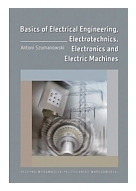Basics of Electrical Engineering, Electrotechnics, Electronics and Electric Machines
This book is especially dedicated as the fundamental background knowledge, to the
students of Hybrid and Electrical Vehicles, Engineering, provided by Warsaw University of
Technology. Anyway, it seems, it could be also useful for other students of Mechanical and
Electrical Engineering Faculties, participating in English lectures.
Introduction
Part I Electrotechnics
1. DC Current Linear Circuits
1.1. Defi nitions & Terminology
1.2. Electrostatic Field
2. Electromagnetic circuits
3. Time Domain Circuit Analysis
4. Alternating Sinusoidal Current
5. Three-phase electric power
Part II Electronics
1. Semiconductor devices
1.1. Diode
1.2. Thyristor (SCR)
1.3. Bipolar junction transistor (BJT)
2. Rectifiers
2.1. Half wave rectifi er
2.2. Full wave rectifi er with centre-tapped transformer
2.3. Full wave bridge rectifier
2.4. Controlled rectifiers
2.5. Three-phase uncontrolled bridge rectifier
3. Amplifier
3.1. Gain of amplifi er
3.2. Frequency response and phase shift
3.3. Basic BJT amplifi er
3.4. Basic BJT amplifi er confi gurations
3.5. Feedback of amplifi er
3.6. Operational amplifi ers (op-amp)
4. Signal generator
Part III Electric Machines
Non-rotating Electric Machines
1. The basics of sinusoidal AC current harmonics generation
2. Oscillating and rotating electromagnetic fi eld
3. AC induction machine – transformer
3.1. Idle state of transformer
3.2. The load condition of transformer
3.3. The simplifi ed equivalent scheme and vector diagram for transformer’s short
circuit
3.4. Power and effi ciency of transformer
3.5. The three-phase transformer
Rotating Electric Machines
1. AC Induction Motor
1.1. Construction of 3-phase AC induction motor
1.2. Principles of operation
1.3. The transformation ratio of AC induction motor
1.4. Rotor and stator currents
1.5. The rotating torque of AC induction motor – electromagnetic torque
1.5.1. Electromagnetic torque
1.5.2. Rotating torque
1.6. Dependence of electromagnetic torque on stator supplying voltage
1.7. Maximum value of electromagnetic torque
1.8. Electromagnetic torque and its maximal value quotient
1.9. Standard torque-speed-slip curves
1.10. Single-phase AC induction motor
1.11. Slip ring motor
1.12. Basics of AC induction motor’s torque-speed control
1.13. Discussion of torque-slip and torque-speed curves for 2-quarter AC induction motor
operation
2. Direct Current (DC) Motor
2.1. DC motor basics
2.2. DC motor basic voltage/torque equations
2.3. The generating mode of DC motor
2.4. Main mechanical characteristics of DC motors
2.4.1. Self-excited DC motor
2.4.2. Series DC motor
2.5. Torque/speed control of DC motor
2.6. Separately excited DC motor dynamic analysis
3. Conventional Synchronous Machine
3.1. Synchronous motor
3.2. Starting synchronous motor powered by a grid – machine synchronization
3.3. The power factor
3.4. PM synchronous Motor
3.4.1. Operating Principles and Construction Evolution
3.4.2. Converter circuits
3.5. PM brushless DC motor (BLDC)
3.6. Automotive alternators
References
196 pages, Paperback
Księgarnia nie działa. Nie odpowiadamy na pytania i nie realizujemy zamówien. Do odwolania !.


